Shape-memory polymers (SMPs) are intelligent materials capable of sensing an external stimulus and entering a transient state according to a stimulus-response, and finally recovering to the initial state through a recovery process, known as the shape memory effect. This behavior divides the SMPs into those showing one-way and two-way shape-memory effects (SME) as shown in Figure 1. The one-way SME is irreversible, meaning that once the shape-memory process terminates, the SMP is fixed to a specific structure artificially to restart the shape-memory process. The performance of these SMPs is termed as the one-way shape-memory effect (1W-SME). In these SMPs, the transitions from temporary shape to permanent shape cannot be repeated by simply reversing the stimulus. Here the shape changing occurs only in one direction (Figure 1a). A new programming process is necessary every time to achieve the temporary shape (after the recovery process) [28,29]. These can be divided into dual-SMPs and multi-SMPs. If the SMP only remembers the temporary shape, then it is termed dual-SMP material. However, if the SMP remembers two or more temporary shapes, then it is termed a triple or multiple-SMP. In multiple-SMPs, the deformed material returns to its original shape step-by-step from two or more temporary shapes, as shown in Figure 1b. Obvious realization of the multi-shape-memory effect (multi-SME) is mainly determined by two kinds of strategies. One strategy is to use polymers with a broad thermal transition in which multiple thermal transitions and temporary shapes are programmed at multiple temperatures across the broad transitions (with different composition materials). In this system, a predominant blend is prepared with broad glass transition that varies with the blend composition (due to miscibility). The other method to achieve broad thermal transition includes grafting, blocking copolymerization of different components, performing chemical cross-linking coupled with supramolecular bonding, etc. The other kind of strategy to achieve multiple-SME is to construct several domains with well-separated thermal transitions. This method involves blending two chemically cross-linked polymers, copolymers or composites. However, the two-way SME responds entirely to external stimuli, is reversible, and does not require additional programming of the material itself. Liquid crystal elastomers [31], cross-linked crystalline polymers [32], and their composites show these features [33]. The two-way reversible shape-memory effect can further be subdivided into quasi two-way and stress-free two-way shape-memory effects [34].
- shape-memory
- artificial muscle
- polymer
- liquid crystal elastomer
Note:All the information in this draft can be edited by authors. And the entry will be online only after authors edit and submit it.
Definition: The Shape-memory property allows Shape-memory polymer materials to be used as shape-memory artificial muscles, which form a subclass of artificial muscles. The shape-memory artificial muscles are fabricated from shape-memory polymers (SMPs) by twist insertion, shape fixation via Tm or Tg, or by liquid crystal elastomers (LCEs). The prepared SMP artificial muscles can be used in a wide range of applications, from biomimetic and soft robotics to actuators, because they can be operated without sophisticated linkage design and can achieve complex final shapes.
1. Introduction
Natural muscles generate enough mechanical energy through enormous driving strain and rapid response to achieve complex movements such as running, swimming, climbing, and flying. Artificial muscles can match specific temporal, spatial, or force regimes typical of biological nature, but so far they cannot fully replicate all of these capabilities [1,2]. Thus, imitating natural muscles has been an essential challenge and opportunity for scientists. However, studies show that the performance of some artificial muscle materials exceeds that of natural muscle in some aspects. They are therefore particularly attractive for many applications where a muscle-like response is desirable, for-example in medical devices, prostheses, robotics, toys, biomimetic devices, and micro/nanoelectromechanical systems [3], in which, the high-loading actuators use electro- and thermo-activated artificial muscles [4,5]. Soft robots can also be used in an extreme biological environment with photo-activated motors [6,7]. Therefore, the field of artificial muscle is highly interdisciplinary and overlaps with various areas such as material science, chemical engineering, mechanical engineering, electrical engineering, and chemistry [3]. Compared to other materials, polymer materials have the advantages of easy preparation, low price, high elasticity, superiorities at large deformation and self-healing. Further, polymeric artificial muscle exhibits excellent multiple stimuli-responses [8,9,10,11]. Therefore, Mirvakili and co-workers [12] demonstrated a multidirectional artificial muscle from a highly oriented nylon filament that could bend and thus eliminate the need for a mechanical transmission mechanism and space for storing long linear actuators. The oriented nylon fiber with a thermal conductivity of 0.1 W·m−1·K−1 showed a 5% deformation with a temperature change from 25 to 140 °C. By cycling the input power, they observed that these nylon fiber actuators had a fully reversible amplitude response over 100,000 cycles.
Although polymeric artificial muscles resemble to a large extent natural muscles, challenges remain within many of the technical applications. Dielectric elastomer actuators (DEAs) are capable of achieving periodic locomotion at high frequencies and generating high power densities; nevertheless, the weight of kilovolt supplies has limited the performance of DEAs [15]. The voltages employed in ionic artificial muscles are low, but they still suffer from high energies because of the close spacing between ions and electronic charges and the transfer of charges [3,16,17,18]. However, SMPs have clear beneficial properties, including their simple, fast response, high extensibility, and high power density with low voltage requirements. They are suitable as easily controllable actuators or heat-activated artificial muscles. Therefore, SMP-based soft actuators have been applied in many robot designs, such as soft swimming robots [19], sequential self-folding or interlocking components [20], hinges for the deployment of a solar array prototype in the aerospace industry [21], and rigid cable inflatable (RI) structures for large space systems [22,23]. Here, we focus primarily on the scientific aspects of shape-memory polymer artificial muscles, including their mechanisms, applications and challenges.
2. Applications of Shape-Memory Polymeric Artificial Muscles
2.1. Thermo-Induced Shape-Memory Polymeric Artificial Muscles
The development of thermally actuated SMPs has focused primarily on relatively low temperatures (Tc < 100 °C) and using elastomeric polymers such as thermoplastic polyurethane (TPU), cross-linked polyethylene, polycaprolactone (PCL) and polynorbornene. These materials were considered appropriate for biomedical applications, such as smart fibers, shrinkable tubes, and aerospace applications using changes in modulus and switching temperature for shape change as well as actuation. These materials consist of network points and molecular switches that are constructed either by physical cross-links of intermolecular interactions or chemical cross-links through covalent bonds. This cross-linking structure leads to phase separation and produces hard segments, soft segments, and domain formation in the polymeric network. Inside this system, the hard segment serves as a pivoting point for shape recovery movement, while the soft segment mainly serves to absorb the external stress that is applied to the polymer [8,70]. Based on intermolecular interactions, these polymers can be further sub-divided into linear and branched polymers. For linear polymers, the shape-memory effect is due to their phase separation and domain orientation in the block copolymers such as PUs and PMMA-g-PEG copolymers. In polyester–urethanes, the oligomer segments serve as hard-segments, while the polyester serves as a switching segment (Figure 3). However, as for PMMA-graft-PEG copolymers, the PMMA is not covalently cross-linked with PEG, but rather the junction point of the backbone and side chains behave as a physical cross-linking point. On other hand, entangled branched copolymers usually take much longer to disappear by the repetitive motion of polymers [22,71]. Further, these materials have the ability of rapid shape recovery and demonstrate a durable elastic nature with bio-compatibility, which is used in biomaterials and shape-memory polymer textiles.
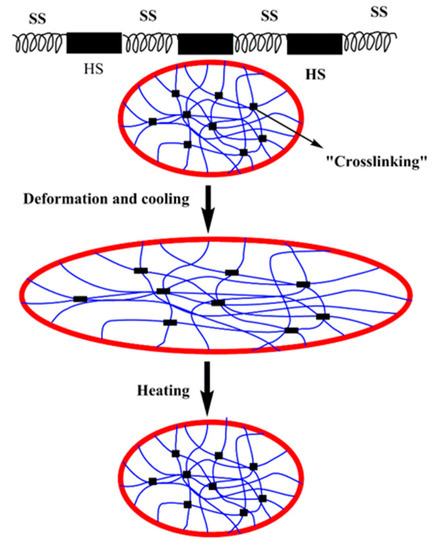
Figure 3. The micro-mechanism of the shape-memory effect of polymers, where HS refers to the hard segment, while SS refers to soft segments.
Similarly, we prepared shape-memory PUPCL copolymer materials [4] with self-healing abilities, which showed a high cycle life. From load lifting experiments, it was observed that these materials were able to lift a load of more than 20 times the mass of the actuator material (Figure 5a). More recently, another type of shape-memory polymer was prepared [88], which was synthesized from PCL, PDMS, and PUs. Along with the high cycle life (based on self-healing behavior), it could also lift a mass 500 times its weight within 5 s and the maximum power density registered was half of the mammalian skeletal muscles (Figure 5b). Moreover, Xie et al. [89] introduced poly (ethylene-co-vinyl acetate)/graphene (cEVA/G) shape-memory actuators. They developed a series of EVA-carbon fiber based composites (EVA/CF) with a remarkably enhanced recovery stress both in a free state and under compressive stress. The addition of CF into EVA increased the modulus and the recovery stresses. Consequently, cEVA/CF composites exhibited a robust shape recovery performance under a counteracting load. This behavior of the composite was well modelled in a deployable device, as shown in Figure 5c. Recently they observed that these materials had a cyclic and dual sensitive (light/thermal) capacity [90]. The cyclic actuation was enabled by crystallization-induced elongation and melting-induced contraction, which was induced by the EVA part of the composites. When using NIR (near infra-red) irradiation and direct heating, an indicating circuit, which used a lamp as an alarm, was enabled to form a conceptual actuator for sensing applications. This actuator could effectively raise a signal (i.e., the lamp is turned on) when responding to a direct heating source, and after removing direct heating, the alarm was disengaged, i.e., light is turned off, and elongation/shape fixation occurred at room temperature. The process repeated itself during shape recovery when the system was heated for recovery to complete the process.
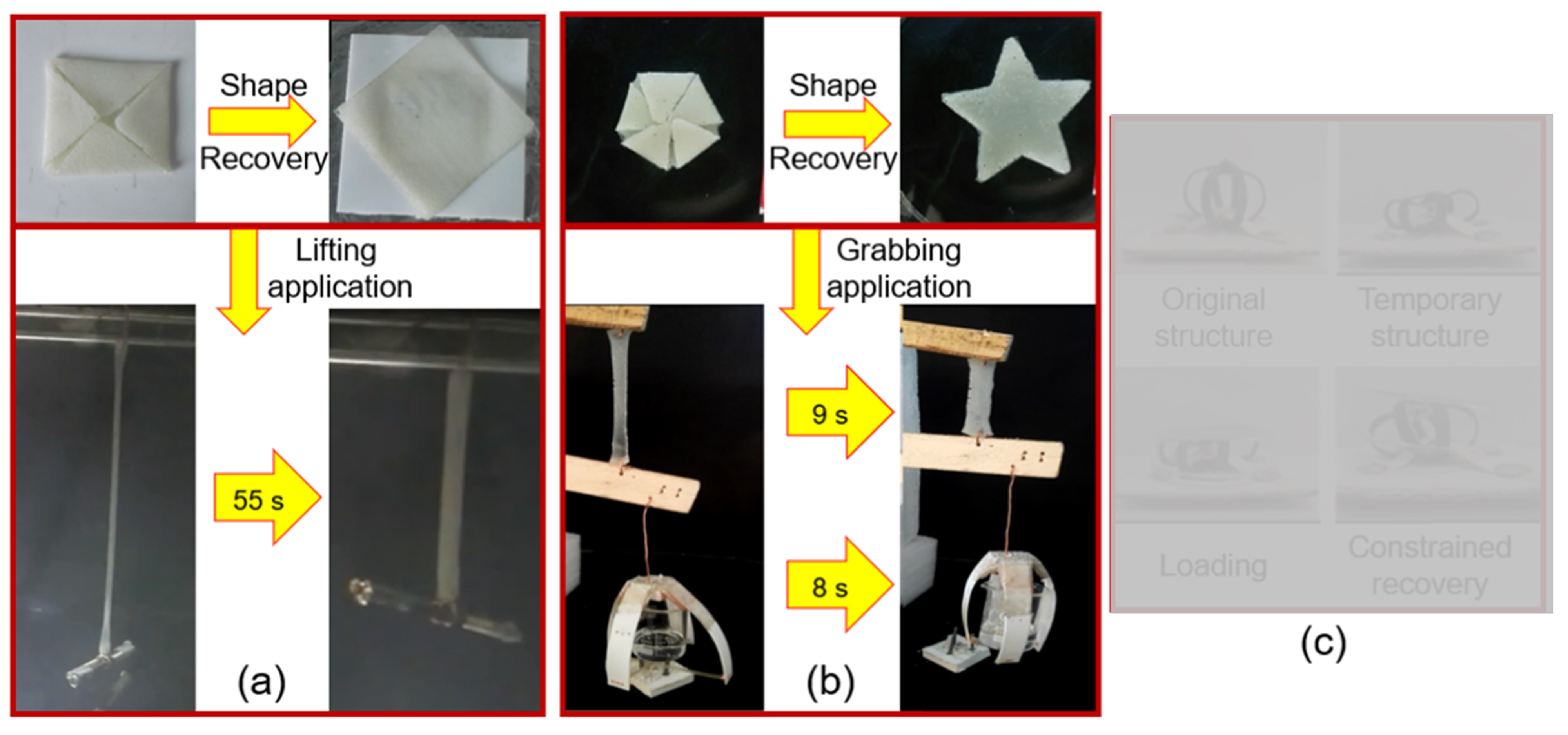
Figure 5. (a) Thermally actuated shape-memory behavior and applications of the PUPCL copolymer (Reprinted (adapted) with permission [4]. Copyright (2018) John Wiley and Sons); (b) the actuation and grasping behavior of the PUPCL-DS copolymer (Reprinted from Materials and Design [88]. Copyright (2019) Elsevier); (c) the deployable device structure made up of cEVA/CF composites shape recovery behavior (Reprinted (adapted) with permission [89]. Copyright (2018) Elsevier).
2.2. Photo-Induced Shape-Memory Polymeric Artificial Muscles
Light-responsive molecules can undergo isomerization in the presence of a particular light stimulus that reversibly changes their structures between two or more chemical aggregates. To be more specific, this kind of isomerization affects the orientation and arrangement within the molecular chains. These changes express themselves in terms of color change or visible deformation on the macro-scale. In recent years, many scientists have prepared a large number of artificial muscles with a specific mechanical strength and light-driven ability by adding organic phases to the polymeric systems, e.g., azobenzene [91] or spiropyran [92], or inorganic phases, e.g., graphene [93], or metal nanoparticles [94,95]. In comparison to thermal-responsive polymers, light-induced polymers have the unique advantages of instantaneous control, environmental friendliness, non-contact initiation, etc., which is of importance in the aerospace, biomedical, and other fields.
The reversible phase transition uses the trans–cis photo-isomerization of azobenzene groups (Figure 6a). The rod-like trans-structure of the liquid crystal phase is stable at room temperature, and the curved cis-structure is easily obtained under external stimuli. Typically, UV irradiation is used to trigger the isomerization phenomenon. For example, the isomerization of a single molecule with shrinkage in its length of 3.5 Å usually starts with ultraviolet irradiation. This isomerization is reversibly restored with visible light radiation as well as heating. Therefore, to obtain a unique controllable deformation, an azobenzene group was added to the polymer network [100]. The continuous accumulation of this isomerism and exposure to ultraviolet irradiation leads to a polymer phase transition. Thus, the final product changes from the anisotropic state to the isotropic state, while causing macro-scale deformation (Figure 6b). On the other hand, the photo-thermal effect can also induce isomerization in the system. This can be achieved by adding appropriate photo-thermal conversion particles, such as carbon materials [101], metal nanoparticles [102], and organic dyes [103]. Therefore, on the exposure of the compound to visible or NIR irradiation, the doped particles serve as a heat source to raise the temperature of the system above the liquid crystal transition point, resulting in the transformation to the isotropic state (Figure 6c). Furthermore, because of the Weigert effect, when the transition distance (long axis) of the trans azobenzene molecule is parallel to the polarization direction of the linearly polarized light, the azobenzene unit will absorb energy to reach the excited state and undergo trans–cis isomerization (Figure 6d). In contrast, the molecules that are perpendicular to the polarization direction do not undergo this process and maintain their initial state. After repeating multiple cycles of trans–cis–trans isomerization, the transition distance of all trans-azobenzenes will be perpendicular to the direction of polarized light. Subsequently, it will become stable and the photo-reorientation of azobenzene will be complete (Figure 6d) [102].
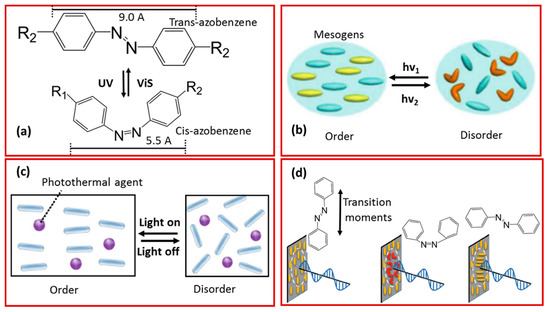
Figure 6. (a) Reversible trans–cis photo-isomerization of azobenzene and schematic illustration of (b) photo-induced and (c) photothermal-induced order–disorder phase transition in LCPs (Reprinted (adapted) with permission [101]. Copyright (2019) John Wiley and Sons). (d) Photo-reorientation of azobenzene containing LCPs with linearly unpolarised light (Reprinted (adapted) with permission [96]. Copyright (2019) John Wiley and Sons).
2.3. Electro-Induced Shape-Memory Polymeric Artificial Muscles
Heating above transition temperatures, such as Tg or Tm, is usually used in shape-memory materials. Therefore, to obtain uniform heating, electrically conducting composites were synthesized by using CNTs, graphene oxide, a CNT membrane, and carbon black as fillers in which the applied voltage yields an electrical pulse and initiates actuation and deformation of the material via Joule heating [115,116,117,118,119]. Thus, the primary source of mediation is the applied field, which provides potential and brings changes in the soft segment of the polymer to restore its original state. This means that the underlying concept required for the shape-memory phenomenon is the same in electro-active (electrically actuated) shape-memory polymers as in thermo-active shape-memory polymers [120,121]. Consequently, these materials have received great interest because of their successful applications in electro-active activators, such as in smart actuators and micro aerial vehicles [122]. The mechanical reinforcement and functionalization of these filler-based SMPs are achieved mainly through the hybridization process. Generally, chemical hybridization is considered superior to physical blending because it can improve interfaces between the polymer and fillers via a fine dispersion process. Furthermore, chemically incorporated fillers provide multifunctional cross-links, which not only augment rubber elasticity but also enhance conventional strength and strain recovery [119,123]. The reason for this is that the CNTs have unique structural arrangements of atoms, a high aspect ratio, and excellent mechanical, thermal, and electronic properties. Additionally, CNTs are highly flexible, which gives them remarkable advantages, making them the best reinforcement component in host polymer matrices [119,124].
Similarly, graphene, which is essentially a CNT cut along its axis so that it unrolls and lays flat, has 2D sp2 hybridization carbons and exhibits excellent electrical conductivity. Further, the 3D interconnection of graphene can be obtained by freeze casting, self-gelation, and chemical vapor deposition. In polymer foams, the graphene not only increases conductivity but also contributes to the improved mechanical properties [123,125,126,127]. Furthermore, carbon fiber and oxidized graphite also show high electrical conductivity because of their high surface area and surface polarity. Using this electrically induced actuation mechanism, Liu et al. [128] studied an electro-active shape-memory composite of a CNT/graphene aerogel (Figure 10a). When CNT and graphene, in a weight ratio of 3:5, were added to an epoxy resin, the electrical conductivity was nearly 16.3 S/m and the composites showed shape recovery after 120 s at a potential difference of 60 V. Mohan and co-workers [129] combined poly (lactic acid) with CNT and obtained a nanocomposite by a normal chemical process as shown in Figure 10d. The nanocomposite had a conductivity of 10−6 S/m with shape recovery behavior within 11 s at a constant voltage of 60 V. The same phenomenon was observed for a composite of Cu-decorated CNTs dispersed in PLA/ESO (epoxydized soybean oil). The nanocomposite recovered to its original shape within 35 s with a voltage of 40 V (Figure 10b) [130].
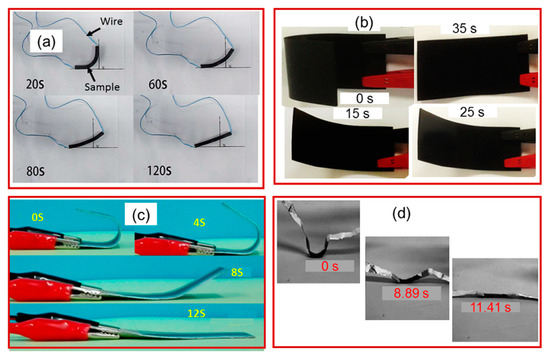
A remarkable shape recovery behavior (within 12 s) was observed for a poly (ethylene-co-vinyl acetate) /Poly(ε-caprolactone) /CNT (EVA/PCL/CNT) blend (Figure 10c). Recently, various synthesis methods were studied for the preparation of electro-active shape-memory polymers, based on the following fillers: graphene oxide [131], carbon black [132], CNT layers [133], TiO2 [134], carbon fibers [135], and single-walled CNTs [136]. Most of these fillers not only made the polymer material conductive but also improved the mechanical properties. Most of the materials showed a shape recovery performance within 60–100 s with an applied voltage of 16–70 V. However, none of these materials showed load-bearing properties. Nevertheless, Yip. et al. [137] prepared high-performance robotic muscles from conductive polyamide 6,6 sewing thread. The nylon 6,6 sewing thread was made conductive by coating it with electric heating, while using the same method as Haines et al. [85]. By using this concept, they prepared a robotic hand with 3D-printed ABS (Acrylonitrile Butadiene Styrene) material. A flexural design with conduits for a tendon was used with supercoiled polymer (SCP) actuators on each tendon (for actuation).
These actuators provided a strain of approximately 10–15% to produce a full range of motion. To mimic the physical location of these muscles in a human arm, they spread them along the forearm of the robot. Further, to cool the actuators during relaxation, four computer fans were used. The power to weight ratio demonstrated by these muscles was 5.38 kW/kg, which is 17 times the power to weight ratio of mammalian skeletal muscles. The grasps were performed within a second without the need for a feedback sensor and with no noticeable crosstalk between actuators. Most recently, Peng’s group [138] prepared a 3D porous network composite material (Figure 11). The porous nanotube served as a built-in integral conductive network, which provided homogenous in-situ Joule heating for the composite polymer. By using this basic concept, they used the material to prepare an inchworm-like robot. The basic design of the robot was that thin metal plates were fixed to both sides of the polymer composites as legs to increase the size of each step (Figure 11). They designed a particular track with a metal sawtooth-like structure. The locomotion of the robot involved releasing and grasping of the front and rear sets of legs. This is because when the robot releases its legs, the rear legs are then stuck to the metal sawtooth, and the front legs push the robot in the forward direction. After grasping, the front leg is hooked on the sawtooth and pulls the rear leg forward. This movement is repeated continuously, in analogy to inchworm locomotion, by cyclic releasing and grasping of the front and back legs. The total time required for a complete cycle was 120 s with an alternating voltage of 2 V and 8 V. The locomotion observed for the inchworm robot was 8 mm in a total time of 10 min, which further increased to 1.2 cm in 10 min when the cycling time was set to 40 s (Figure 11c). These robots were considered to have profound potential with numerous advantages, such as their simple structure, light weight, and low cost, with designable parameters including speed, frequency, and length.
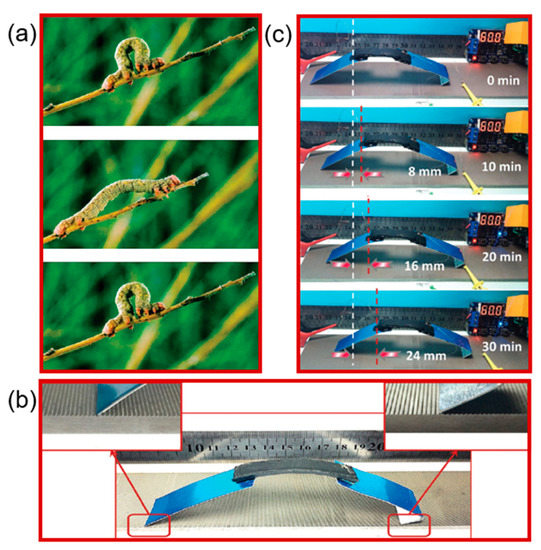
Figure 11. Application of an electro-active shape-memory polymer composite to an inchworm robot. (a) Photographs of inchworm locomotion. (b) Illustration of a designed inchworm robot with a double layer CNT–SMP composite in connection with two metal plates as moving legs. (c) Snapshots of an inchworm-type robot in locomotion. It has moved over 24 mm in 30 min (Reprinted (adapted) with permission [138]. Copyright (2016) Royal Society of Chemistry).
4. Concluding Remarks with Future Perspectives
Exciting properties of SMPs have endowed these materials with desirable utility for artificial muscle applications. In the past, most of the applications were based on SMP actuators. However, along with the development of SMP programming methods, cross-linking methods (in various combinations) and different trigger methods suggest that more applications in the form of artificial muscles, robotic fingers, deployable devices, and robotics can be realized. Fundamentally, SMP artificial muscles are providing a new alternative to natural muscles by imitation, which inspires and challenges the material scientists to untangle the structure–property and application relationships. It is intriguing to see that the artificial muscle performance in some cases exceeds that of natural muscles, which depends not only on the intrinsic properties of these materials but also on the actuation mechanisms, miniaturization and specific design. Aside from the significant progress in SMP artificial muscles, some continuous effort should be put into the following aspects of SMPs and composites, which have been mostly unexplored to date.
Among existing SMPs, polycaprolactone, polyurethane, specific epoxy resin and LCEs are often used as artificial muscles, presumably because these materials have a crystalline domain, which induces the shape-memory phenomenon. Exploration of new polymer systems with similar properties to these materials may lead to new functionalities and applications in the field of artificial muscles.
It is generally accepted that SMP artificial muscles usually mimic human muscles, but there is a lack of SMPs that mimic the strength associated with the actuation of humanoid muscles. Therefore, appropriate methods are needed to quantitatively assess the contribution of different factors that affect the mechanical performance of polymer-based actuators.
A large effort has been devoted to controlling the load-bearing performance of SMP artificial muscles, but little is known about how to develop millions of reversible contractions with rapid load-bearing abilities. Distinguishing different SMP networks would help greatly in understanding better the structure–property relationship and reversible relaxation abilities with maximum cycles.
Current knowledge of SMP artificial muscles is generally based on shape-memory polymer networks and their composites with thermal or electrical actuation. However, little is known about LCEs and their regular systems. Therefore, thorough study is needed to address many questions related to LEC-based SMP artificial muscles, activated either thermally, electrically, or by light.
Limited fatigue resistance and cracks on the surface of these materials is a significant limitation at the current stage. Therefore, the combination of these materials with self-healing materials may provide a possible solution to the development of new self-healing or self-recovery SMP artificial muscles.
Combined with the load lifting performance, the development of new multifunctional artificial muscles with opto-active or magneto-active shape-memory performance in a miniaturized form is still a big challenge. Despite many attempts for the most common applications of SMP artificial muscles, the actual arrangement of these in robotic design is one of the highly essential issues that need to be taken into account.
Furthermore, the electrical actuation of the electro-active SMPs is carried out by dispersion of fillers, for example, CNTs in the polymer network. Sometimes, weak linkages of these fillers in a polymer chain may induce defects that significantly reduce the strength. Therefore, better annealing and optimized synthesis conditions are required to overcome these defects and junctions between the nanotube yarns in the polymer networks.
How to effectively dissipate the heat when the SMPs are restored to the original shape is also a big challenge. This is critical to load-bearing two-way SMPs with many shape-changing cycles. Hence, the investigation of SMPs should be combined with new technologies of thermal management, which will bring SMP research closer to real applications.
This entry is adapted from the peer-reviewed paper 10.3390/molecules25184246
